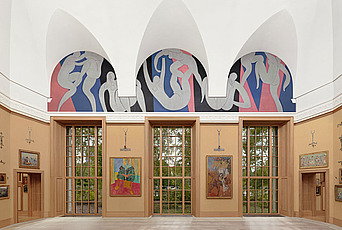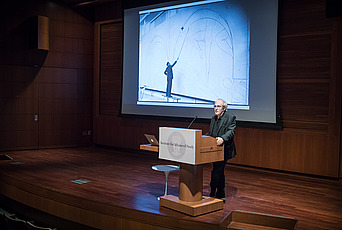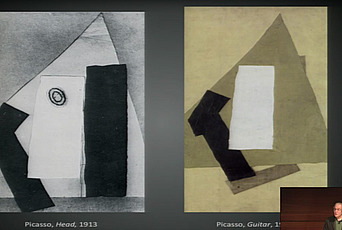Matisse in the Barnes Foundation
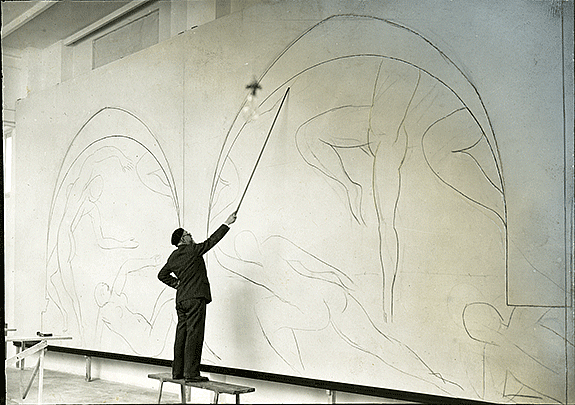
Matisse gave two separate accounts of the moment at which he began work on the first version of The Dance, each of them emphasizing the immensity of the surface he had to master, “to possess,” as he put it. In the first version, it is an architectural rhyme that triggers the onset of this sense of possession:
As I was pacing in front of my seventy-two square meters of white canvas destined to become the decoration of Doctor Barnes, not knowing which way to start, I noticed by chance a rope hanging from a window to a random spot in my studio, standing out and projecting a curve on my canvas. I suddenly had before me the relationship of this curve to the great rectangle of the edges of my decoration. This was the first connection with the surface to decorate, made of three pointed arches, and it is this unexpected connection that allowed me to begin taking possession of this large surface.
The jolt comes from an encounter with real space (the real space of the makeshift studio’s architecture, which Matisse paces), with real scale—that is, with the relative proportions of specific elements in that space (the curve made by the rope’s shadow, the body of the artist) vis-à-vis the real surface quantity of the canvas. The phenomenology of this encounter, an immersion in the thick of things, has nothing to do with the distanced, imaginary space of projection. Matisse is particularly eloquent about this when he writes to Raymond Escholier, his first biographer, about the Barnes Dance:
Perhaps it would be important to signal that the composition of this panel came out of a hand-to-hand combat [un corps à corps: literally, “a body-to-body combat”] of the artist with the fifty-two square meters of surface of which the mind of the artist had to take possession, and not from the modern method of projection of a composition on a much larger surface, traced “on demand.” The man who looks for a plane in the sky with a beam [projecteur] does not scour its immensity in the same way as the aviator. I think you understand, if I am expressing clearly, the essential difference between these two conceptions.
Still, the second version of what kicked off Matisse’s sense of taking possession is perhaps more surprising than the first, architecturally driven anecdote:
Faced with my huge white canvases, I took a model and began a study that had nothing to do with the decoration. At each of the model’s breaks, I relaxed by looking at these great surfaces, absentmindedly—or so I thought. Then, at a certain point, there came a flash of inspiration. I took my big charcoal, attached it to the end of a big bamboo, and began drawing the circle of my dancers, from one end to the other of my thirteen-meter surface. I’d got off the mark, taken possession of my surface entirely through the power of my imagination. That’s how I made my painting: entirely from feeling, without a model.
The first thing that is striking about Matisse’s explanation is the sheer athleticism of his technique: looking at photographs in which he is indeed shown drawing The Dance with a bamboo stick as long as he is tall (and he would do the same a quarter of a century later when working on his Vence chapel!), one wonders where he got the strength and balance (try it and see for yourself!). Then there is the role of the model: the fact that she was a mere presence whom Matisse did not watch or even think about (though he was conscious of her body, which must have enhanced his sense of scale) is not so astonishing. What is, however, is that Matisse’s account does not correspond to the facts, for he did make use of a model at first for studies that had everything to do with The Dance, and stopped doing so only when he realized he no longer needed them. He obviously forgot this episode, and that, in itself, is quite telling.

Even before his second trip to Merion, in December 1930, to get a better feel for the space, Matisse worried about the model he would use. He somewhat reluctantly opted for Lisette Löwengard, who was tending Matisse’s wife at night and had already posed for many hours for two paintings that were still eluding him (The Yellow Dress, which he may have finished as late as the spring or summer of 1932, and Woman with a Madras Hat, which would remain incomplete). From Merion he wrote to his wife to keep an eye on Lisette’s diet and exercise so that she would be able to perform the acrobatics he wanted to sketch. The drawings in question, filling two whole sketchbooks, are extraordinary. They all belong to the category of the rapid drawing that he had mastered with Marquet in his youth—a drawing that captures the singularity of a movement or posture in a few strokes. This drastic economy has nothing to do with the slow process of gradual purification and condensation to which Matisse would still subscribe, a few months later, in the plates of the Mallarmé book. The drawings are minimal, to be sure, but done in a matter of seconds. In them, Matisse is no longer trying to refine an essence but rather to internalize it—to capture within himself, synesthetically, as it were, the very movement he draws. He wants to identify with this movement, to draw as if he were dancing.
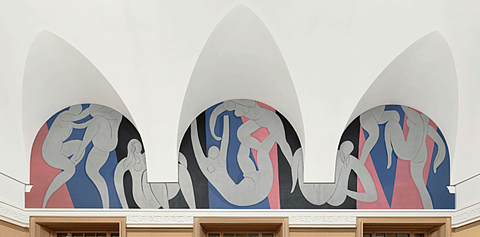
Matisse wrote and spoke on numerous occasions about his desire to identify with his model (whether it was a female nude or a tree), but to my knowledge these statements only began to appear after his work on The Dance. It is as if it was only then, perhaps because he had at last found a way to accomplish this identification, that he could verbally articulate the intensity of this desire. And when he did so retrospectively, one of the first examples that came to his mind was the memory of his work on Le Bonheur de vivre’s central group of dancers. Painting in his studio, all he needed to do was to sing the same tune that the dancers used to sing at the Moulin de la Galette while making a round, hand in hand, at the end of the session, which he had so often observed. He summoned the same tune again, he noted, when working on the Dance for Shchukin in 1909–10, and then once more when engaged on the Barnes commission: “I was whistling while painting. I was almost dancing. . . .” It is thus not by chance that, in 1939, in order to expound his new theory and practice of drawing, Matisse would reach for the analogy of a dancer or a funambulist:
It is in order to liberate grace and character that I study so intensely before making a pen drawing. I never impose violence on myself; to the contrary, I am like the dancer or tightrope walker who begins his day with several hours of numerous lumbering exercises so that every part of his body obeys him, when in front of his public he wants to give expression to his emotions by a succession of slow or fast dance movements, or by an elegant pirouette.
However, we are not quite there yet, in the early months of 1931, when Matisse is jotting on paper the soubresauts or splits he is asking Lisette to perform. Pierre Schneider has rightly identified what is still lacking in those sketches (as well as the series of lithographs that resulted from them) to redirect Matisse’s drawing in a fundamentally new, irreversible path:
They are in fact exceptions, unlike most of the drawings of his mature years, for the artist is so absorbed in his effort to condense the forms and figures of dance that he forgets about their relationship to the page. To be sure, there is no negation of the white surface in these drawings—no attempt to introduce a fictive space—but the paper is neutralized rather than brought to life.
Furthermore, those drawings are centered. In other words, Matisse has not yet gone through the experience of the Mallarmé book—in whose plates he felt that the drawing “spreads over the whole sheet.” Does that mean that the two modes (the quasi-somatic identification one observes in the rapid sketches and the allover investment of the surface) are incompatible? Not at all, as Matisse’s subsequent drawing practice shows. But the compatibility of the two modes is something he learned while working on The Dance, I surmise, perhaps in summoning his old procedure of the blind drawing—a procedure in which the physical, bodily contact with the paper, and the kinesthetic evaluation of its size, play a role as big as, if not bigger than, visual memory, in the marks traced by the hand.
Shortly before he started using the concept of the unconscious in his statements, Matisse had made reference to “reflex.” (Speaking to Tériade about Manet in January 1932—when he was fully engrossed in the work on The Dance—he praised the painter for having been “the first to have made an immediate translation of his sensations, thus liberating the instinct. He has been the first to act by sheer reflex and in doing so to simplify the work of the painter.”) It is unfortunate, in some sense, that the term was displaced so soon thereafter (in a year’s time) by the word “unconscious,” for the muscular connotations of “reflex” are much closer to the kind of nonconscious, quasi-automatic mechanism that Matisse wanted to be triggered when he was drawing. What he had in mind is akin to what Henri Bergson, the only philosopher he is known to have read with some constancy, called the “memory of the body,” and to what Marcel Proust (of whom he was also fond) called the “involuntary memory of limbs.” It was this involuntary memory, and the kind of reflex activation of his body that it effected, that allowed him to get rid of the model when he worked on The Dance and, once he had taken in its considerable extension, had “identified” with it, to begin the hand-to-hand combat with its surface.
